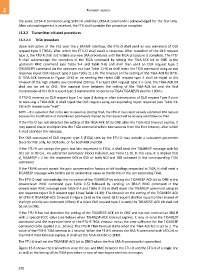Page 980 - 5G Basics - Core Network Aspects
P. 980
2 Transport aspects
the same L2TSA-R command using SFDC=0 until the L2TSA-R command is acknowledged for the first time.
After acknowledgement is received, the FTU shall consider the procedure complete.
13.2.2 Transmitter initiated procedures
13.2.2.1 TIGA procedure
Upon instruction of the VCE over the γ_MGMT interface, the FTU-O shall send an eoc command of OLR
request type 3 (TIGA), after which the FTU-O shall await a response. After reception of the OLR request
type 3, the FTU-R shall not initiate any new SRA procedures until the TIGA procedure is complete. The FTU-
R shall acknowledge the reception of the TIGA command by setting the TIGA-ACK bit to ONE in the
upstream RMC command (see Table 9-4 and Table 9-8) and shall then send an OLR request type 1
(TIGARESP) command via the upstream eoc (see Table 11-9) or shall reject the TIGA command using an eoc
response reject OLR request type 3 (see Table 11-19). The timeout on the setting of the TIGA-ACK bit (FTU-
O TIGA-ACK timeout in Figure 13-6) or on sending the reject OLR request type 3 shall be equal to the
timeout of the high priority eoc command (50ms). If a reject OLR request type 3 is sent, the TIGA-ACK bit
shall not be set to ONE. The maximal time between the setting of the TIGA-ACK bit and the first
transmission of the OLR request type 1 command in response to TIGA (TIGARESP) shall be 100ms.
If FTU-O receives an OLR request type 1 or type 2 during or after transmission of OLR request Type 3 prior
to receiving a TIGA-ACK, it shall reject the OLR request using corresponding reject response (see Table 11-
19) with reason code "wait".
NOTE – It is expected that in the aim to speed up starting TIGA, the FTU-O may reject already submitted SRA request
because the modification of transmission parameters implied by this request will be anyway overridden by TIGA.
If the FTU-O has not detected the setting of the TIGA-ACK bit to ONE after the TIGA-ACK timeout expires, it
may resend one or multiple time the TIGA command within two seconds from the first timeout, after which
it shall abandon the message.
The OLR command of OLR request type 3 (TIGA) sent by the FTU-O may include a subcarrier parameter
block for NOI only, for DOI only, or for both NOI and DOI.
If the FTU-R can accept the gains and bits requested in TIGA, it shall send the TIGARESP message with bb
bits set to 00 (i.e., no subcarrier parameter blocks included, see Table 11-9). In this case, it is implied that
d_TIGARESP = 1 for the respective NOI or DOI or both NOI and DOI indicated in the corresponding TIGA
command.
If the FTU-R cannot accept the gain compensation factors or bit loadings requested in TIGA, it shall send a
TIGARESP message with bb bits set to an identical value as the bb bits in the corresponding TIGA.
The FTU-O shall acknowledge the reception of the TIGARESP by setting the TIGARESP-ACK bit to ONE in the
downstream RMC command (see Table 9-5) followed by sending an SRA-R RMC command in the
downstream RMC message (see Table 9-4 and Table 9-15) or shall reject the TIGARESP command using an
eoc response reject OLR request type 1 (see Table 11-19). The timeout on the setting of the TIGARESP-ACK
bit (FTU-R TIGARESP-ACK timeout in Figure 13-6) or the reject OLR request shall be equal to the timeout of
the high priority eoc command (50ms). If a reject OLR request type 1 is sent, the TIGARESP-ACK bit shall not
be set to ONE.
If the FTU-R has not detected the setting of the TIGARESP-ACK bit to ONE and has not received an SRA-R
with a special SCCC value (see below) when TIGARESP-ACK timeout expires, it may re-send the TIGARESP
command until the expiration time of the FTU-R TIGA timeout minus the time sufficient for the TIGARESP
command to be applied (i.e., 50 ms). The FTU-R TIGA timeout starts when the TIGA-ACK bit is set to 1. The
value of the FTU-R TIGA timeout is 1 second. When the FTU-R detects the SRA-R command with SFDC=0 or
the FTU-R TIGA timeout expires, it shall set the TIGA-ACK bit to ZERO.
The FTU-O shall set the TIGARESP-ACK bit to ZERO when the first SRA-R command is transmitted.
Figure 13-6 shows the transactions over the eoc and RMC between the FTU-O and the FTU-R of a single line
as well as the timing of the TIGA procedure in case of non-segmented eoc messages.
970

